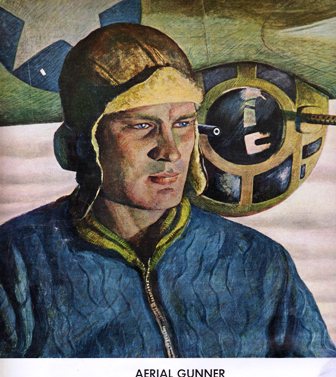 Sergeant Mike Zuk, 19, is the youngest member of the Air Forces to pose for LIFE Artist Peter Hurd. He used to go to a Ford Motor Co. apprentice school in Detroit where he was learning to be a tool-and-die maker. When he joined the Army in December 1941, he was sent to the aerial gunnery school at Las Vegas, Nev. From there he went to England. When he first arrived at the bomber station there was no room for him in a Fortress crew, so he was put on an armament squad, charged with loading bombs and incendiaries and checking and testing the machine guns with which he is now so proficient. When a gunner's place opened up on the "Kissimee Kowboy," commanded by Lieut. Clarence Thacker of Kissimee, Fla., Zuk got his chance to fly.
Sergeant Mike Zuk, 19, is the youngest member of the Air Forces to pose for LIFE Artist Peter Hurd. He used to go to a Ford Motor Co. apprentice school in Detroit where he was learning to be a tool-and-die maker. When he joined the Army in December 1941, he was sent to the aerial gunnery school at Las Vegas, Nev. From there he went to England. When he first arrived at the bomber station there was no room for him in a Fortress crew, so he was put on an armament squad, charged with loading bombs and incendiaries and checking and testing the machine guns with which he is now so proficient. When a gunner's place opened up on the "Kissimee Kowboy," commanded by Lieut. Clarence Thacker of Kissimee, Fla., Zuk got his chance to fly.Mike's job is the coldest and most exposed one in a heavy bomber. He hangs in his ball turret (shown in the background) beneath the belly of his B-17 ready to deal with any fighter making an attack at the plane's underside. He is joined to his plane by three long umbilical cords--a wire which heats his blue flying suit by conducting current from the bomber's generators, an oxygen line from the plane's tanks and an interphone communications wire. From his strange position he looks down over the Channel and the fields of France, directing his power turret from side to side to better his aim. His two .50-cal. machine guns are a match for any German fighter.
To help Zuk and all ball-turret gunners keep their sense of direction in such an unnatural position, every Fortress has a red spot painted on the underside of the left wing and on the tail fin--a green spot on the right wing and right side of the tail fin. In the heat of battle, with commands from the pilot and other crew members coming thick and fast over the interphone, that is the only way the aerial gunner in the ball turret can be sure he knows which side is which.
When a Fortress squadron is tactically disposed by its commander in a defensive formation, its aerial gunners cover every angle of approach with deadly streams of cross fire. Their heavy machine guns usually outrange those of the enemy fighters and it is suicide for them to come too close. The secret of American high-level bombing success has been due to this fact, for even unescorted Fortresses can meet enemy fighters, hold them off until the bombs are accurately dropped and then fly safely back to their home bases, shooting down German planes on the way.
Life February 15, 1943
No comments:
Post a Comment